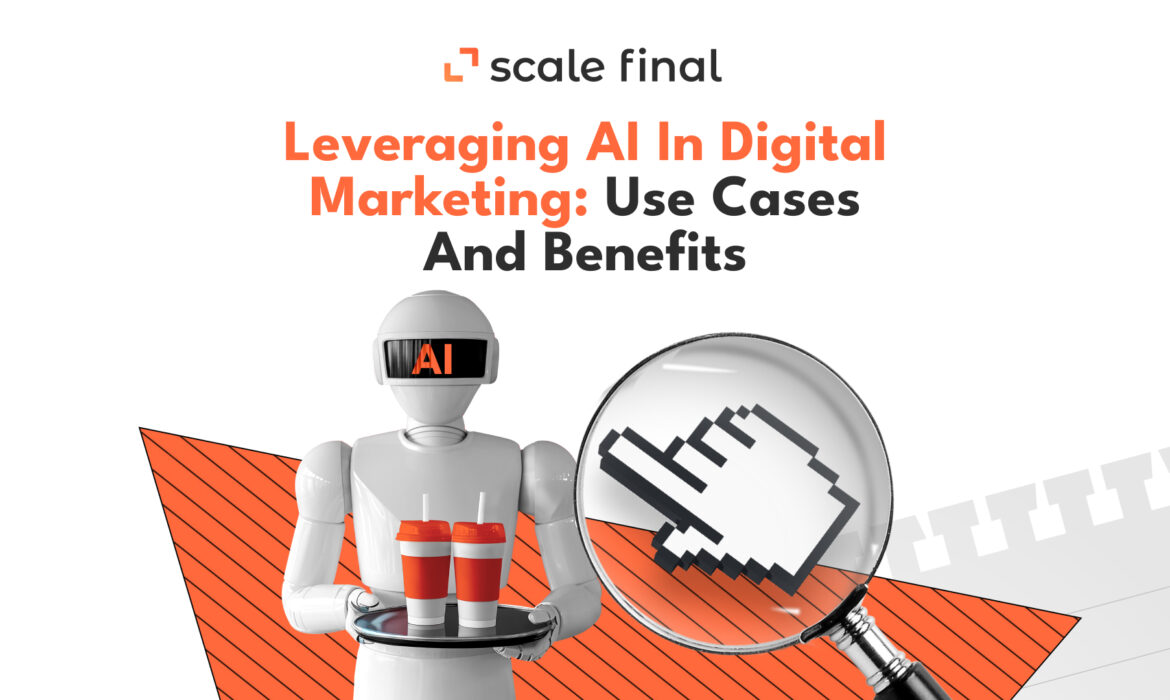Home • Blog • Leveraging AI in Digital Marketing: Use Cases and Benefits
Leveraging AI in Digital Marketing: Use Cases and Benefits
Most of us, businesses as a whole and mere workers of the industry, are still figuring out how to most effectively use Ai, this evolving technology. And it’s not like it’s just a big word. While AI might be as not as hyped as it was back in 2023, and whilst tools of all kinds have been used literally across the board, in 2024 it is still perceived as too hyped, – read, the technology is not there yet, so what’s the fuzz?
Yet, a more clear sentiment is emerging: AI is relatively immature, but these current limitations work in favor, and they offer a great potential, and not just for the developers. And for the mere workers, even with this current state of AI, there’re already huge benefits and great use cases, that we’re about to share in this article.
One more quick word before jumping in: this article will suit only those seeking how to optimize your daily and work life, and it’s certainly not for the benefit of those who just want it to be shoehorned into your work or products just for the sake of it, not adding any value what so ever.
If you’d be interested, we will write an exposure article of these fishy AI use cases, just let us know.
Now we begin.
Has AI Fully Arrived In The Industry?
At this point, we pick up on some findings that we have already published in our weekly Marketing Digest – Dripped Digest – on LinkedIn: It turns out that despite the fact that the media liked to exaggerate the “transformative” impact of AI on the world of work, the pace of adoption has slowed compared to 2023.
In Retool’s survey on the current state of AI, while many respondents said that their companies are either “running” or “flying” when it comes to AI adoption, overall the number of those who consider themselves leaders has dropped from 13.4% in 2023 to 9.8% in 2024.
Furthermore, the progress reported by respondents is largely not transformative — or at least not yet: the impact of these use cases is rated an average of 6.7 out of 10.
And here are some more juicy facts.
Even though AI is so great, not all workers are allowed to use AI at work. A higher percentage of 64.2% in 2024 compared to 54% are allowed to use AI freely, but still more than a quarter (27.3%) of employees use AI secretly.
And why?

So, this article has just taken a turn. The translation of the data above and the whole sentiment of this article: If your company doesn’t know where it stands on AI yet, you could be one of the workers using AI in secret, or join them. Or you could use it as an opportunity to talk to managers about whether you and your team should be allowed to use AI for whatever reason.
It’s a good thing we’ve already prepared a list of the big WHYs: why is it useful and why is it safe.
AI Use Cases

Am I the only one who, when confronted with something completely new, is the first to check whether there is an AI tool that is created to help with exactly that?
But let’s start with the most common use cases of AI and then go into more detail.

Chatbots for support, which are often used as an example of chatbot usage, are only the third most popular internal live use case for respondents, with writing code or queries coming in first at 42.1%, followed by knowledge base questions at 36.4%. The use cases for content creation are more mixed.
While most use cases were within a few percentage points compared to our last check at the end of 2023, there was a divergence of around 5 percentage points in some areas – trends we will keep an eye on:
Writing code or queries dropped 5.4 points from 47.5 to 42.1%, as did texting from 32.9% to 28%
Support chatbots increased by 5 points from 28.9 to 33.9%
Automation of workflows increased by almost 5 percentage points from 12.9 to 17.8%
Quick note: Although Retool calls AI notebreakers a harmless use case, we at Scale Final use them daily, and although it’s very simple, it increases productivity and keeps us all on the same page. On a side note, there’s no room for those who weren’t paying attention or weren’t even present during the conversation.
And now for more application examples from our team:
Sviatoslav P., CMO:
- Perplexity for search information.
- Claude for high-quality texts.
- Chat GPT api for Google Sheets.
- Ideogram for image creation.
- PIXLR for AI image processing.
Mariia L., graphic designer:
- Midjourney, DALL-E for image creation.
- Magnific.ai for improving the quality of images.
- Heygen for the creation of video avatars.
- ElevenLabs for audio generation and AI synchronization.
- Adobe Firefly (and AI in Photoshop&Illustrator) – For image creation and enhancement.
- ChatGPT for the creation of prompts, scripts and other information.
- Veed.io for the creation of videos.
- CapCut Captions for speech recognition.
Semyon I., Youtube head:
Igor V., a full-stack developer, and I, Yana P., a content writer, speak from the heart:
ChatGPT is the king of kings. It’s great when you’re investigating or learning about a new tool or service. It speeds up the process immensely. It’s also great when you need a simple explanation with pros and cons that gives you a basic understanding before you dive in.
One more present: 41 tools for everything in digital marketing. Just follow the link and enjoy your streamlined processes.
AI Benefits: Improving Individual and Organizational Performance

While the use of AI technology is still in its infancy, it is undeniably changing the way we work— – transforming tasks from the mundane to the complex. Despite the gradual adoption and mixed feelings about the current possibilities, the benefits of AI on an individual and organizational level are significant and deserve attention.
1. Increased efficiency and productivity: AI tools have proven successful in automating repetitive tasks, allowing employees to focus on more strategic and creative tasks. This not only increases productivity, but also job satisfaction by reducing the burnout associated with tedious tasks.
2. Improved decision making: AI’s ability to analyze large amounts of data quickly and accurately provides employees and managers with insights that were previously unattainable. This data-driven approach supports better business decisions and promotes a more analytical and informed company culture.
3. Increased creativity and innovation: By taking over routine analysis and data monitoring, AI frees up individuals and encourages creativity. New ideas and innovative solutions are more likely when minds are not bogged down by routine analysis.
4. Scalability of services: AI is able to handle and respond to variable workloads without the need to increase headcount accordingly. This scalability is particularly beneficial for functions such as customer service and IT support, where AI-driven chatbots can provide instant answers to common questions.
5. Personalized experiences: At a more granular level, AI enables the customization of work experiences by tailoring tools and interfaces to individual preferences and task areas, improving user engagement and efficiency.
The preconception that AI is a revolutionary but underutilized tool is gradually changing. As organizations learn to harness its full potential, the transformative impact of AI on the workplace will increase, making it an indispensable factor in the digital age. Integrating AI into daily workflows is not just about technological adoption, but also about cultural alignment to ensure that all levels of an organization are aligned and moving forward together.
Author
-
 ScaleFinal Content Writer
ScaleFinal Content WriterExperienced writer in different domains. I package meaning into words and bring people together. Know how to convey the vision and values of a product in writing. I like reading, movies, sports and blockchain.
View all posts






